Multiple Choice
Identify the
choice that best completes the statement or answers the question.
|
|
|
1.
|
The Mitochondrion of a cell
a. | has only one membrane | b. | has no membrane | c. | is
circular | d. | is where cellular respiration occurs |
|
|
|
2.
|
Which of the following statements is true of ribosomes?
a. | They are the site of protein synthesis | b. | They are made by other
ribosomes | c. | They have their own DNS | d. | none of the
above |
|
|
|
3.
|
Structures that support and give shape to plant cells
a. | microbodies | b. | Golgi bodies | c. | nucleus | d. | Cell Walls |
|
|
|
4.
|
The storage of hereditary infromation in a eukaryotic cell is in the
a. | cytoplasm | b. | nucleus | c. | centrioles | d. | lysosomes |
|
|
|
5.
|
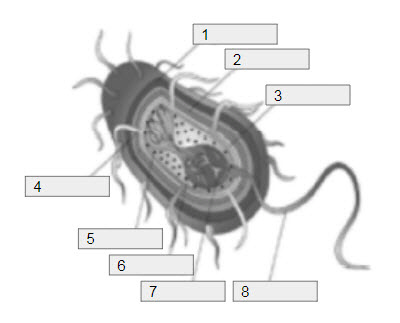 Identify Number 1 a. | Capsule | b. | Cell Wall | c. | Cell
Membrane | d. | Pilus |
|
|
|
6.
|
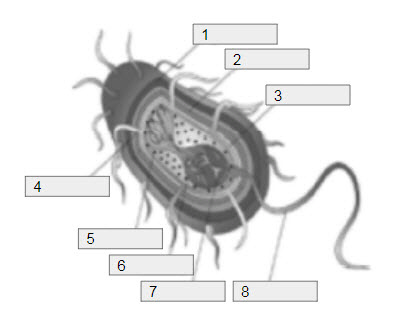 Identify Number 2 a. | Capsule | b. | Cell Wall | c. | Cell
Membrane | d. | Pilus |
|
|
|
7.
|
 Identify Number 3 a. | Capsule | b. | Cell Wall | c. | Cell
Membrane | d. | Pilus |
|
|
|
8.
|
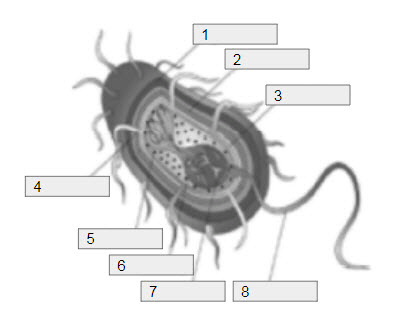 Identify Number 4 a. | Capsule | b. | Cell Wall | c. | Cell
Membrane | d. | Pilus |
|
|
|
9.
|
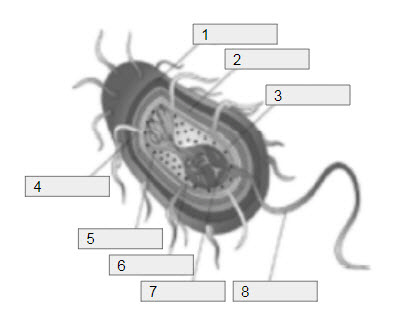 Identify Number 5 a. | Ribosome | b. | DNA | c. | Cell
Membrane | d. | Pilus |
|
|
|
10.
|
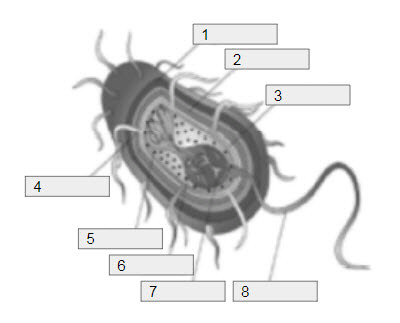 Identify Number 6 a. | Ribosome | b. | DNA | c. | Cell
Membrane | d. | Nucleoid |
|
|
|
11.
|
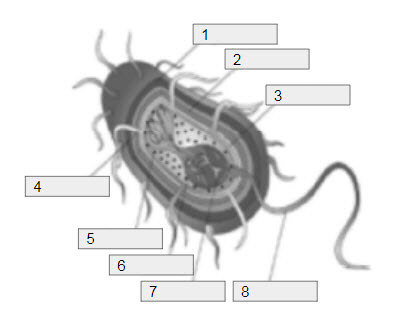 Identify Number 7 a. | Ribosome | b. | DNA | c. | Cell
Membrane | d. | Nucleoid |
|
|
|
12.
|
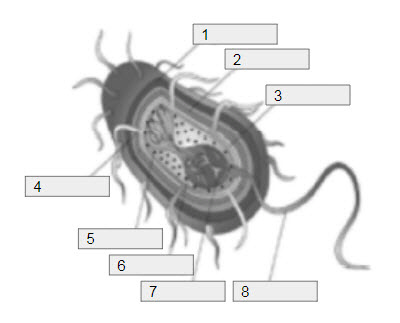 Identify Number 8 a. | Flagellum | b. | DNA | c. | Cell
Membrane | d. | Nucleoid |
|
|
|
13.
|
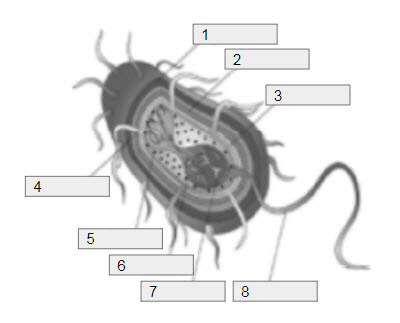 What kind of cell is in this
diagram? a. | Prokaryotic | b. | Animal | c. | Plant | d. | Eukaryotic |
|
|
|
14.
|
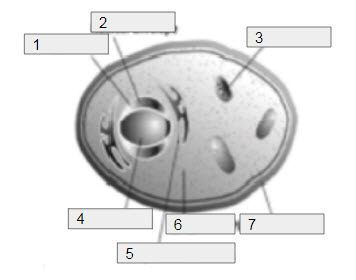 What kind of cell is in this
diagram? a. | Prokaryotic | b. | Animal | c. | Plant | d. | Eukaryotic |
|
|
|
15.
|
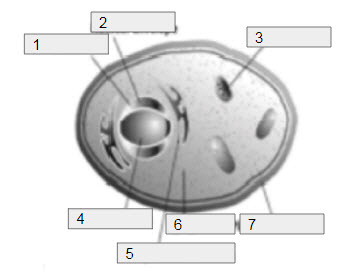 Identify number 1? a. | Nuclear Pores | b. | Plasma Membrane | c. | Nuclear
Envelope | d. | Mitochondria |
|
|
|
16.
|
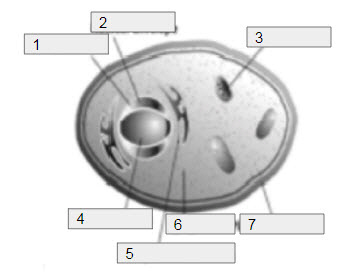 Identify number 2? a. | Nuclear Pores | b. | Plasma Membrane | c. | Nuclear
Envelope | d. | Mitochondria |
|
|
|
17.
|
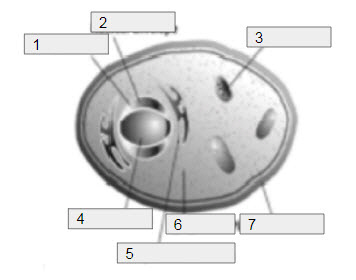 Identify number 3? a. | Nuclear Pores | b. | Plasma Membrane | c. | Nuclear
Envelope | d. | Mitochondria |
|
|
|
18.
|
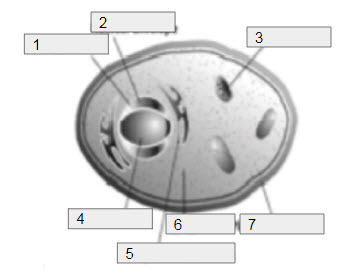 Identify number 4? a. | Nucleus | b. | Plasma Membrane | c. | Nuclear
Envelope | d. | Mitochondria |
|
|
|
19.
|
 Identify number 5? a. | Nucleus | b. | Plasma Membrane | c. | Nuclear
Envelope | d. | Endoplasmic Reticulum |
|
|
|
20.
|
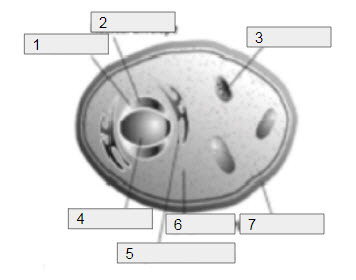 Identify number 6? a. | Cytoplasm | b. | Plasma Membrane | c. | Nuclear
Envelope | d. | Endoplasmic Reticulum |
|
|
|
21.
|
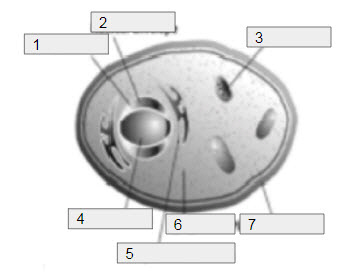 Identify number 7? a. | Cytoplasm | b. | Plasma Membrane | c. | Nuclear
Envelope | d. | Endoplasmic Reticulum |
|
|
|
22.
|
Rigid membrane around the plant cell; made of cellulose; provides shapes and
support
a. | Cell Wall (plants only) | b. | Modified Cell Wall (bacteria and fungi
only) | c. | Plastids (plants only) | d. | Vacuoles |
|
|
|
23.
|
Bacteria and fungi also have a cell wall but it is made from different materials
than that of a plant cell
a. | Cell Wall (plants only) | b. | Modified Cell Wall (bacteria and fungi
only) | c. | Plastids (plants only) | d. | Vacuoles |
|
|
|
24.
|
group of structures used in photosynthesis and product storage; have a double
membrane and provide color and cellular energy
a. | Cell Wall (plants only) | b. | Modified Cell Wall (bacteria and fungi
only) | c. | Plastids (plants only) | d. | Vacuoles |
|
|
|
25.
|
spherical storage sac for food and water
a. | Cell Wall (plants only) | b. | Modified Cell Wall (bacteria and fungi
only) | c. | Plastids (plants only) | d. | Vacuoles |
|
|
|
26.
|
membrane surrounding the cell that allows some molecules to pass
through
a. | Cell membrane | b. | Modified Cell Wall (bacteria and fungi
only) | c. | Plastids (plants only) | d. | Vacuoles |
|
|
|
27.
|
Flattened membrane sacs for synthesis, packaging, and distribution.
a. | Cell membrane | b. | Modified Cell Wall (bacteria and fungi
only) | c. | Golgi Apparatus (golgi body) | d. | Vacuoles |
|
|
|
28.
|
Rod-shaped double membranous structures where cellular respiration takes
place.
a. | Mitochondria | b. | Modified Cell Wall (bacteria and fungi
only) | c. | Golgi Apparatus (golgi body) | d. | Vacuoles |
|
|
|
29.
|
Fibers and tubes of protein that help move internal cell parts.
a. | Microfilaments and microtubules | b. | Modified Cell Wall (bacteria and fungi
only) | c. | Golgi Apparatus (golgi body) | d. | Vacuoles |
|
|
|
30.
|
Folded membranes having areas with and without ribosomes used for transport of
RNA and proteins.
a. | Microfilaments and microtubules | b. | Endoplasmic Reticulum | c. | Golgi Apparatus
(golgi body) | d. | Vacuoles |
|
|
|
31.
|
Dense body in the nucleus; site of ribosome production
a. | Microfilaments and microtubules | b. | Endoplasmic Reticulum | c. | Golgi Apparatus
(golgi body) | d. | Nucleolus |
|
|
|
32.
|
Control center of the cell; location of hereditary information has a double
membrane that has small holes.
a. | nucleolus | b. | Endoplasmic Reticulum | c. | Golgi Apparatus
(golgi body) | d. | Nucleus |
|
|
|
33.
|
Structures that manufacture proteins found on endoplasmic reticulum and floating
in the cytoplasm..
a. | nucleolus | b. | Endoplasmic Reticulum | c. | ribosomes | d. | Nucleus |
|
|
|
34.
|
Short tube necessary for cell reproduction in some cells.
a. | nucleolus | b. | Centrioles (animal cell
only) | c. | ribosomes | d. | Nucleus |
|
|
|
35.
|
Spherical sac containing enzymes for digestive functions.
a. | nucleolus | b. | Centrioles (animal cell
only) | c. | lysosomes | d. | Nucleus |
|
|
|
36.
|
Short,hair-like extensions on the surface of some cells used for movement and
food gathering.
a. | nucleolus | b. | cilia | c. | flagellum | d. | Nucleus |
|
|
|
37.
|
Long, whip-like extension on the surface of some cells used for
movement.
a. | nucleolus | b. | cilia | c. | flagellum | d. | Nucleus |
|
|
|
38.
|
Jelly- like substance in the cell around nucleus and organelles.
a. | nucleolus | b. | cilia | c. | flagellum | d. | cytoplasm |
|
|
|
39.
|
Is a structure that helps cells maintain their shape and internal
organization.It also provides mechanical support,enabling cells to perform essential functions like
division and movement.
a. | nucleolus | b. | cilia | c. | cytoskeleton | d. | cytoplasm |
|
|
|
40.
|
Cell that does not have a true nucleus.Although the genetic material in a
central location,a membrane does not surround it.
a. | Prokaryotic | b. | Eukaryotic | c. | Animal | d. | Plant |
|
|
|
41.
|
Cell has a nucleus surrounded by nuclear membrane.It also has several membrane
bound organelles.
a. | Prokaryotic | b. | Eukaryotic | c. | Animal | d. | Plant |
|